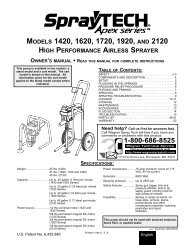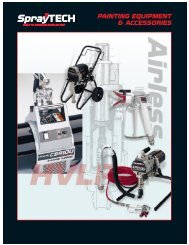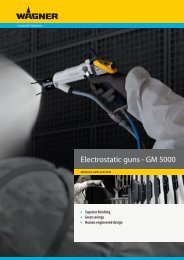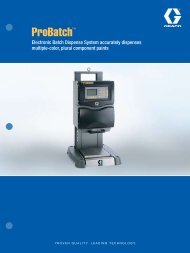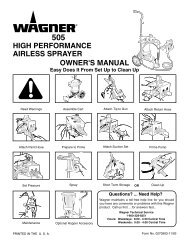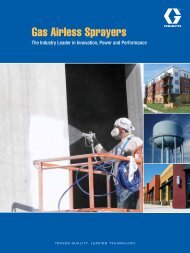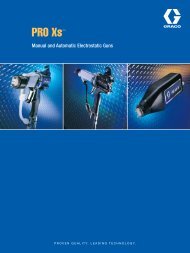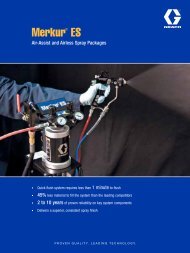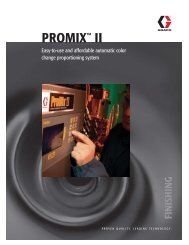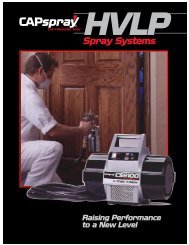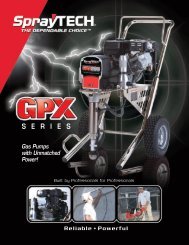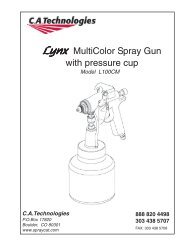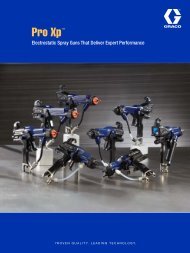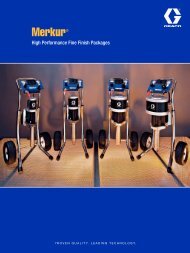Wagner HVLP Training Manual - Spray Tech Systems Inc.
Wagner HVLP Training Manual - Spray Tech Systems Inc.
Wagner HVLP Training Manual - Spray Tech Systems Inc.
Create successful ePaper yourself
Turn your PDF publications into a flip-book with our unique Google optimized e-Paper software.
<strong>HVLP</strong><br />
TRAINING<br />
MANUAL<br />
High Volume<br />
Low Pressure<br />
Equipment<br />
Form No. 0279612A
Contents<br />
Introduction . . . . . . . . . . . . . . . . . . . . . . . . . . . . . . . . . . . . . . . . . . . . . . . . . . . . . . . 1<br />
<strong>Spray</strong>ing Methods . . . . . . . . . . . . . . . . . . . . . . . . . . . . . . . . . . . . . . . . . . . . . . . . 2-3<br />
When to use <strong>HVLP</strong> Equipment . . . . . . . . . . . . . . . . . . . . . . . . . . . . . . . . . . . . . . 3<br />
How does <strong>HVLP</strong> Work? . . . . . . . . . . . . . . . . . . . . . . . . . . . . . . . . . . . . . . . . . . . . 4<br />
How to Acquaint the Painter with <strong>HVLP</strong> . . . . . . . . . . . . . . . . . . . . . . . . . . . . . . 5<br />
<strong>HVLP</strong> System Components . . . . . . . . . . . . . . . . . . . . . . . . . . . . . . . . . . . . . . . . 6-8<br />
Maxum I <strong>HVLP</strong> <strong>Spray</strong> Gun Adjustments . . . . . . . . . . . . . . . . . . . . . . . . . . . . . 9<br />
Maxum I Air Cap Adjustments . . . . . . . . . . . . . . . . . . . . . . . . . . . . . . . . . . . . 10<br />
<strong>Spray</strong> <strong>Tech</strong>niques . . . . . . . . . . . . . . . . . . . . . . . . . . . . . . . . . . . . . . . . . . . . . . 11-13<br />
Choosing a Projector Set . . . . . . . . . . . . . . . . . . . . . . . . . . . . . . . . . . . . . . . . . . . 14<br />
Projector Set Recommendation Chart . . . . . . . . . . . . . . . . . . . . . . . . . . . . . . . . 15<br />
Cleaning Your Equipment . . . . . . . . . . . . . . . . . . . . . . . . . . . . . . . . . . . . . . . . . . 16<br />
<strong>HVLP</strong> <strong>Spray</strong> Equipment/Finish Troubleshooting . . . . . . . . . . . . . . . . . . . 17-18<br />
Sherwin-Williams CAPspray 5100 . . . . . . . . . . . . . . . . . . . . . . . . . . . . . . . . . . . 19<br />
Sherwin-Williams CAPspray 8100 . . . . . . . . . . . . . . . . . . . . . . . . . . . . . . . . . . . 20<br />
Sherwin-Williams CAPspray 9100 . . . . . . . . . . . . . . . . . . . . . . . . . . . . . . . . . . . 21<br />
Sherwin-Williams Portable Cart . . . . . . . . . . . . . . . . . . . . . . . . . . . . . . . . . . . . . 22<br />
Mounting Models 5100, 8100 or 9100 . . . . . . . . . . . . . . . . . . . . . . . . . . . . . . . . 23<br />
Sherwin-Williams CAPspray 3100 . . . . . . . . . . . . . . . . . . . . . . . . . . . . . . . . . . . 24<br />
Assistance/Warranty . . . . . . . . . . . . . . . . . . . . . . . . . . . . . . . . . . . . . . . . . . . . . . 25<br />
Notes . . . . . . . . . . . . . . . . . . . . . . . . . . . . . . . . . . . . . . . . . . . . . . . . . . . . . . . . . 26-28
Introduction<br />
1<br />
The contractor market for <strong>HVLP</strong> spray systems is the fastest-growing market<br />
segment in the spray equipment industry. As you’ll soon realize, <strong>HVLP</strong><br />
sprayers represent a tremendous opportunity to help painters become more<br />
competitive and profitable. Used primarily for finishing work, <strong>HVLP</strong> sprayers<br />
work hand-in-hand with airless equipment to help contractors reduce the time<br />
and material necessary to complete a job.<br />
The key is minimized overspray. <strong>HVLP</strong> systems atomize coatings by means<br />
of low air pressure (2-10 PSI) (pounds per square inch) and high air volume<br />
(10-25 CFM) (cubic feet per minute), so the user can expect transfer efficiency<br />
ranging from 65-90 percent. The result is:<br />
• Less time masking and prep work<br />
• Less material waste<br />
• Less time cleaning up<br />
• MORE PROFITS<br />
In addition, the high transfer efficiency of <strong>HVLP</strong> assists contractors to comply<br />
with new clean air laws designed to reduce volatile organic compounds<br />
(VOC) emissions. <strong>HVLP</strong> paint sprayers help protect the environment–and<br />
painters–by reducing overspray and bounceback.<br />
This manual will give an overview of <strong>HVLP</strong> technology and uses; it will also<br />
focus on the specific features and operation of Sherwin-Williams/CAPspray ®<br />
<strong>HVLP</strong> equipment.<br />
Transfer Efficiency %<br />
100<br />
90<br />
80<br />
70<br />
60<br />
50<br />
40<br />
30<br />
20<br />
10<br />
Air <strong>Spray</strong><br />
TRANSFER EFFICIENCY<br />
Airless <strong>Spray</strong><br />
Air-Assisted<br />
Airless<br />
Electrostatic<br />
High Volume<br />
Low Pressure<br />
(<strong>HVLP</strong>)<br />
Application Methods–Liquid Coatings<br />
Note: Transfer efficiencies may vary according to the operator and equipment condition.<br />
This chart gives broad ranges only.
<strong>Spray</strong>ing Methods<br />
<strong>HVLP</strong><br />
Conventional Air <strong>Spray</strong><br />
Airless <strong>Spray</strong>ers<br />
2<br />
Two types of <strong>HVLP</strong> systems dominate the painting contractor market:<br />
portable turbines and direct hook-up guns. The two systems use completely<br />
different air sources, but atomize material in similar manners.<br />
Portable Turbine<br />
Most commonly found in the painting contractor market for portable<br />
applications, this type of <strong>HVLP</strong> system uses a centrifugal blower motor as<br />
the air source.<br />
Direct Hook-up Guns<br />
Direct hook-up guns require an air compressor as the air source. The guns<br />
will generally require from 10-25 CFM. These guns are primarily used in<br />
stationary booth applications.<br />
Direct Hook-up High Flow Regulator Guns<br />
High flow regulator guns utilize an attached, high flow regulator, which<br />
increases air flow and reduces air pressure to achieve <strong>HVLP</strong> results.<br />
Regulators deliver a more precise pressure setting than direct hook-up guns<br />
because the regulator is adjustable right at the gun.<br />
Conventional air spray atomizes material at high air pressure (35 to 80 PSI)<br />
and moderates air flow. The negative aspect of conventional air spray is<br />
excessive overspray and bounceback that results from high air pressure.<br />
Conventional air spray creates excessive turbulence at the air cap, which<br />
contributes to excess overspray. Bounceback results from the material being<br />
discharged from the nozzle, moving to the substrate at a very high velocity<br />
and bouncing off the substrate. The advantage of this method is ultra-fine<br />
atomization and a high rate of application. Conventional systems are used<br />
on finishing work ranging in size from small jobs to production lines. They<br />
generally are found in stationary applications. Required components are an<br />
air compressor, air hose and conventional spray gun.<br />
Airless sprayers atomize coatings by forcing the paint through a small tip<br />
opening at very high fluid pressure. Working fluid pressures range from<br />
1200 to 3600 PSI. Airless spray transfer efficiency is higher than conventional<br />
air spray (see chart on page 1), and offers the ability to spray the widest<br />
variety of coatings.<br />
Airless sprayers typically are portable with gas, electric and air operated<br />
available. The primary application is production work. These systems are<br />
capable of covering large areas in a short amount of time. When used<br />
properly–correct fluid pressure, hose length and tip size–airless systems<br />
handle the widest range of applications. As a result, it is rare to find a<br />
commercial painting contractor who does not own or need airless<br />
spray equipment.
<strong>Spray</strong>ing Methods<br />
Air-Assisted Airless<br />
Electrostatic <strong>Spray</strong><br />
When to use <strong>HVLP</strong> Equipment<br />
3<br />
Air-assisted airless sprayers offer fine finish capabilities combined with<br />
a medium production rate. Air-assisted technology uses a combination of<br />
airless and air spray. Fluid pressure ranges from 700 to 900 PSI, with air<br />
intermixed at 15 to 30 PSI. The systems typically are found in stationary<br />
and portable fine finish production applications. Transfer efficiency for<br />
air-assisted airless ranges from 40 to 65%.<br />
Electrostatic spray systems charge the paint at the tip. The charged particles<br />
move within the electrostatic field, which is attracted to the grounded object,<br />
forming an even coating on its entire circumference. When used properly, the<br />
result can be high transfer efficiency with uniform mil thickness.<br />
A variety of electrostatic systems are available, including conventional airless<br />
and air-assisted. Applications include chain link fences, wrought iron, lockers,<br />
and metal office furniture.<br />
<strong>HVLP</strong> equipment is classified as a finishing tool. It is not designed to be used<br />
for covering large, flat surfaces, except when using specialty coatings, such as<br />
multi-spec, or where overspray may be hazardous.<br />
<strong>HVLP</strong> systems are designed to cut labor time, minimize waste, and improve<br />
the final finish on the substrate. In addition to enhancing profitability, in<br />
many states <strong>HVLP</strong> is compliant with the most stringent transfer efficiency<br />
requirements. For this reason, you can expect the <strong>HVLP</strong> sprayer market will<br />
continue to grow at an accelerated pace.<br />
<strong>HVLP</strong> Applications <strong>Inc</strong>lude:<br />
Touch-up<br />
Dentil molding<br />
Crown molding<br />
Cabinets<br />
Door jambs<br />
Elevator doors<br />
Frames<br />
Bi-fold doors<br />
<strong>HVLP</strong> Features:<br />
High transfer efficiency<br />
Minimal bounceback<br />
<strong>Spray</strong>s most materials<br />
Reduced prep and clean-up<br />
Affordable<br />
Inexpensive to maintain<br />
Controlled spraying<br />
Implement equipment<br />
Six-panel doors<br />
Appliances<br />
Porcelain<br />
Furniture<br />
Lockers<br />
Shutters<br />
Dividers<br />
Gutters<br />
General maintenance<br />
Wicker furniture<br />
Shelving<br />
Pipes<br />
Multi-color finishes<br />
Louvered doors<br />
Overhangs<br />
Portability<br />
Reduces material consumption by 40%<br />
Three spray patterns available<br />
Works from 15-amp service<br />
Cuts labor time<br />
<strong>Spray</strong>s patterns from 1 /4" to 12"<br />
Low fluid pressure means low wear<br />
Moisture-free atomizing air
How Does <strong>HVLP</strong> Work?<br />
4<br />
A pressure vessel (1-quart cup, 2-quart cup, or pressure pot) supplies<br />
paint to the gun, where a large amount of low pressure air intersects with<br />
the paint stream breaking the paint into small particles. This process is<br />
called atomization.<br />
High volume of air<br />
in from turbine<br />
Air diverted to atomize paint<br />
Low pressure stream of paint<br />
Air diverted to pressurize the cup<br />
Pressure causes paint to flow to spray gun<br />
Since the pressures are much lower, the atomized paint has less bounceback.<br />
This means less overspray, greater transfer efficiency and better control.<br />
High volume of<br />
air from turbine<br />
Little bounceback, greater control<br />
Low pressure paint from container
How to Acquaint the Painter with <strong>HVLP</strong><br />
5<br />
The most effective way to show the advantages of <strong>HVLP</strong> equipment is to<br />
demonstrate it. Contractors will see how they can save labor hours, use less<br />
paint and increase profits.<br />
<strong>HVLP</strong> sprayers are not for every painter. Be certain they are involved with<br />
the appropriate finishing application. Then match the correct unit size and tip<br />
size to the type of materials they use.<br />
After you have determined the answers to these questions, consider more<br />
specific criteria:<br />
• Will the system be used in a stationary or portable application?<br />
• Does the painter need a one-quart cup system, a two-quart,<br />
or a 2 1 / 2 -gallon material capacity for continuous use?<br />
• Will the painter need extra maneuverability with the gun?<br />
• Is maximum hose length a consideration?<br />
• How often will the painter use the sprayer?<br />
The significance of answers to these and other questions are discussed in the<br />
following portion of the handbook. However, the demonstration remains the<br />
most critical component. We can guide you through a demonstration, but you<br />
still must put paint in the cup, be prepared, and be confident. Under those<br />
conditions, the equipment will sell itself.<br />
Before operating a Sherwin-Williams CAPspray <strong>HVLP</strong> spray system,<br />
please review the owner’s manual. The manual includes all of the<br />
information needed to properly operate and maintain <strong>HVLP</strong> equipment.<br />
Also keep in mind these basic safety considerations:<br />
• Always spray in a well-ventilated area. Always comply with appropriate local,<br />
state and national codes governing ventilation, fire prevention, and operation.<br />
• Never spray near sparks, open flames or hot surfaces. Some coating materials<br />
are highly flammable.<br />
• Before each use, check all material hoses (if you are utilizing them) for cuts,<br />
leaks, abrasions, cover bulging or movement of couplings. If any of these<br />
conditions exist, replace the hose immediately. Never repair a paint hose.
<strong>HVLP</strong> System Components<br />
Air Source<br />
6<br />
As with most sprayers, three distinct components make up an <strong>HVLP</strong> system:<br />
air source, air hose, and <strong>HVLP</strong> spray gun. There are several variations of<br />
these components depending upon the manufacturer. We will deal primarily<br />
with Sherwin-Williams CAPspray equipment.<br />
The air source is the heart of the system. It provides the CFM and PSI required<br />
to atomize coatings. Depending on the type of gun and the application<br />
requirements, there are two types of air sources–air compressor and turbine.<br />
Air Compressor<br />
Air compressors are used as the air source when using either direct hook-up<br />
guns or high-flow regulator systems. Because of high CFM requirements with<br />
<strong>HVLP</strong> direct hook-up guns, the minimum compressor size recommended is<br />
5 HP. Due to the overall size and electrical requirements of 5 HP air compressors,<br />
portability is limited. In most cases, direct hook-up guns which require an air<br />
compressor as the air source are confined to stationary applications.<br />
Turbine<br />
The turbine is the most common air source found in the painting contractor<br />
market. A turbine is a high-speed centrifugal blower motor which provides<br />
the gun with high CFM flow at low air pressures. Because of the high<br />
RPM–20,000 RPM in some cases–the air is frictionally heated. This eliminates<br />
all moisture from the atomizing air. The high RPM also increases the atomizing<br />
air temperature by as much as 80 degrees, reducing flash time and helping<br />
to minimize blushing. All CAPspray turbines are commercially rated,<br />
heavy-duty and designed for continuous use.<br />
By-Pass Turbine with Tangential Discharge<br />
The tangential discharge turbine is used in the by-pass configuration, using<br />
separate cooling and intake fans. This turbine comes from the manufacturer<br />
with a built-in air outlet. This type of turbine is found in the 5100, 8100 and<br />
9100 units.<br />
Although there are many variations and uses, the main function of a turbine<br />
in <strong>HVLP</strong> equipment is to generate a high volume of air at air pressures less<br />
than 10 PSI. A critical element in determining the amount of air pressure that a<br />
turbine can generate is the number of stages. A stage, within a turbine, can be<br />
viewed as an individual compression chamber. The greater the number of<br />
stages within a turbine, the higher the PSI the turbine is able to produce–the<br />
more PSI the turbine produces, the heavier the viscosity of material that can<br />
be sprayed.<br />
Cooling Fan<br />
Brush (2)<br />
Motor<br />
2 Stage Turbine<br />
Air Exhaust<br />
Air Intake
<strong>HVLP</strong> System Components<br />
Air Hose<br />
Maxum I <strong>HVLP</strong><br />
<strong>Spray</strong> Gun<br />
7<br />
Please note that while air flow (CFM) and pressure (PSI) are both important<br />
in determining the turbine‘s ability to atomize coatings, pressure is the key.<br />
All manufacturers rate their turbines in the range of 50-170 CFM.<br />
Whether the turbine produces 50 or 170 CFM, it will still have enough air<br />
flow to support the gun. The gun only uses about 25 CFM. Therefore, CFM as<br />
a measure of performance can be misleading. Pressure determines the velocity<br />
of the air moving through the air cap. This creates the turbulence at the<br />
nozzle, and in turn atomizes the coating. The more pressure, the higher the<br />
velocity and the better the ability to break up more viscous coatings.<br />
The air hose often is ignored, but it is a key element of the <strong>HVLP</strong> system.<br />
Its function–transferring air from the power source to the gun–cannot be<br />
overlooked. The CAPspray hose is specifically designed to withstand heat and<br />
solvents, while remaining lightweight and pliable.<br />
Hose Length<br />
To determine the maximum air hose length with a turbine, use this general<br />
rule of thumb: double the length of hose that comes standard with the<br />
turbine. Example: If 15 feet of hose comes with the turbine, the painter<br />
can use a maximum hose length of 30 feet. Just screw the hoses together to<br />
extend the length.<br />
The Sherwin-Williams CAPspray ® Maxum I Non-bleeder Gun is the most<br />
versatile, painter-friendly <strong>HVLP</strong> gun available on the market.<br />
Stainless steel<br />
needle and nozzle<br />
to minimize wear<br />
Click-in air cap for quick<br />
pattern adjustment –<br />
and no guesswork<br />
<strong>Inc</strong>reased internal air<br />
passages for greater<br />
flow, higher pressure<br />
and the ability to handle<br />
heavier coatings<br />
(better atomization)<br />
External packing nut makes<br />
adjustments easy<br />
Teflon seals are solvent-resistant<br />
for easy cleanup<br />
Optional air inlets<br />
provide non-bleed<br />
to bleed conversion<br />
for greater versatility<br />
Composite handle with<br />
patented grip design for<br />
stay-cool operation<br />
Multi-position pick-up tube for longer<br />
use without refill, when spraying at<br />
angles (floors, ceilings)<br />
(continued)
<strong>HVLP</strong> System Components<br />
Maxum I <strong>HVLP</strong><br />
<strong>Spray</strong> Gun<br />
(continued)<br />
Non-Bleeder Gun<br />
vs. Bleeder Gun<br />
Optional Air Inlet<br />
8<br />
<strong>HVLP</strong> guns differ from conventional air spray guns in two main areas:<br />
One difference is the size of the internal air ports. Conventional gun air<br />
port openings are approximately 1 /4''. <strong>HVLP</strong> guns need more air and use<br />
openings 5 /8'' in size. That makes the air ports more than 6 times as large as<br />
those in conventional guns. Keep in mind that <strong>HVLP</strong> atomizes with a high<br />
volume of air and low pressure.<br />
The second major difference is the manner in which the material is moved<br />
from the cup out of the nozzle. <strong>HVLP</strong> units pressurize the cup, forcing<br />
material to the nozzle. A conventional gun creates a vacuum to siphon<br />
material to and through the nozzle.<br />
The term non-bleeder means that when the user releases the trigger of the gun,<br />
the air flow stops. With a two-stage trigger, the user will first feel air coming<br />
from the air cap; trigger further and material flow will begin. With a bleeder<br />
gun, air flows continuously; the trigger only starts and stops the paint flow.<br />
The Maxum I Gun offers two air inlet locations: one on the bottom of the<br />
handle for non-bleeder set up and the second directly behind the air control<br />
valve. To set up the gun in bleeder spray mode, remove the air control knob<br />
and replace it with the air inlet fitting from the bottom of the gun. Close the<br />
air inlet fitting with the plug supplied with the gun. The air hose can now be<br />
attached to the gun. When using this location, the gun becomes a bleeder gun<br />
by always discharging air. This location is particularly helpful spraying inside<br />
lockers or cabinets.<br />
Another area to utilize the top air inlet is to improve atomization with very<br />
heavy materials. This can be done by bypassing the air valve so air is directly<br />
channeled to the air cap.<br />
Patented conversion feature allows you to change<br />
to a bleeder gun if the job requires it.
Maxum I <strong>HVLP</strong> <strong>Spray</strong> Gun Adjustments<br />
Air Control Valve<br />
Material Flow<br />
Adjustment<br />
External Packing Nut<br />
One-Way Valve<br />
9<br />
To produce the highest-quality finish possible, the spray gun requires the<br />
proper air and material adjustments. You control the air flow with the air<br />
control valve, located at the rear of the gun.<br />
Note the notch that is cast into the control knob on the valve. Air flow is at its<br />
fullest when the knob is set at the 12:00 position. Rotating the valve 180° either<br />
direction cuts off the air.<br />
The air control valve is used when spraying with light viscosity materials or<br />
in confined areas, such as cabinets or lockers. When spraying light material,<br />
full air is not needed. Restrict the valve until you achieve proper atomization<br />
without excess overspray.<br />
Packing Nut<br />
The amount of paint fed<br />
from the cup out the nozzle<br />
is controlled by the material<br />
adjustment knob located at<br />
the heel of the gun, just above<br />
the handle. To decrease paint<br />
flow, turn the fluid<br />
adjustment knob clockwise.<br />
To increase the paint flow,<br />
turn the knob<br />
counter-clockwise. A little<br />
experimentation will give<br />
you the correct combination<br />
of paint and air necessary<br />
to achieve the desired finish<br />
and fan size. The material<br />
adjustment can also be used to set a specific trigger pull, so the same pattern<br />
size and material flow are consistently obtained on each pass.<br />
The external packing nut, located directly in front of the trigger, is used to<br />
adjust the packing so a seal is maintained around the needle.<br />
The one-way valve, or<br />
serviceable check valve, is<br />
designed to allow air into the<br />
cup, putting the material under<br />
pressure, yet not releasing the<br />
cup pressure. CAPspray‘s<br />
one-way valve prevents paint<br />
from seeping up the air tube<br />
into the air passages of the gun.<br />
It also eliminates any delay in<br />
material flow when the gun<br />
is triggered.<br />
Minimum<br />
Air Flow<br />
Maximum Air Flow<br />
CAPspray‘s one-way valve is<br />
easily detached for cleaning purposes. The valve simply rotates to open for<br />
cleaning and contains a disk that can be removed and cleaned with soap and<br />
water for waterborne materials or a compatible solvent for other materials.<br />
MAX<br />
Minimum<br />
Air Flow<br />
Air control<br />
Material flow
Maxum I Air Cap Adjustments<br />
Air Cap<br />
<strong>Spray</strong> Pattern<br />
The Fan Size<br />
10<br />
CAPspray‘s exclusively designed guided air cap makes it virtually impossible<br />
for the painting contractor to misalign. This translates to better spray<br />
pattern control.<br />
The air cap determines the spray pattern. It is crucial the air cap remains<br />
clean and free of dried paint.<br />
The Sherwin-Williams CAPspray <strong>HVLP</strong> gun offers a choice of three spray<br />
patterns: horizontal flat, vertical flat and round. To select the desired pattern,<br />
simply rotate the two air cap ”ears” until they click into the desired position.<br />
An up and down position gives you a horizontal pattern. When the ears are<br />
side by side, you will get a vertical pattern. And when the ears are diagonal,<br />
the pattern is round. Never trigger the gun while adjusting the spray pattern.<br />
Diagonal<br />
Cap Position<br />
Round <strong>Spray</strong><br />
Pattern<br />
Horizontal<br />
Cap Position<br />
To change fan size, change the distance from the<br />
surface to the gun nozzle. The closer you are to<br />
the surface, the smaller the pattern becomes.<br />
Moving back increases the fan size.<br />
Trigger pull will also vary the fan size.<br />
The greater the trigger pull, the greater<br />
the material flow and fan size.<br />
Vertical <strong>Spray</strong><br />
Pattern<br />
Another way to adjust fan size is to move the<br />
air cap in (clockwise) for a larger pattern or out<br />
(counter-clockwise) for a smaller pattern.<br />
When getting started, the air cap should be flush<br />
with the fluid nozzle. This will give you the full<br />
range of pattern size control.<br />
Vertical<br />
Cap Position<br />
Horizontal <strong>Spray</strong><br />
Pattern<br />
Larger<br />
pattern<br />
Smaller<br />
pattern<br />
<strong>Spray</strong> pattern width is adjustable<br />
from 1 /4'' to 12''.
<strong>Spray</strong> <strong>Tech</strong>niques<br />
<strong>Spray</strong>ing <strong>Tech</strong>niques<br />
How to Make the<br />
Correct Pass<br />
Overlapping<br />
Each Pass<br />
11<br />
Position the spray gun perpendicular to and 1 to 8 inches from the spray<br />
surface. <strong>Spray</strong> parallel to the surface and use controlled, smooth passes at an<br />
even speed. Start by applying a thin coat of material on the first pass and<br />
allow it to tac before applying a second, slightly heavier coat.<br />
When spraying, trigger the spray gun before starting your pass, and release<br />
trigger before stopping the pass. The best results will occur when making<br />
passes about 20 inches. Keep the gun perpendicular to the surface and overlap<br />
passes approximately 50% to obtain the most consistent, professional finish.<br />
Start<br />
pass<br />
here<br />
Correct<br />
Pull trigger<br />
First pass aimed at edge of panel<br />
Pull trigger<br />
<strong>Inc</strong>orrect<br />
The CAPspray gun is not “all on” or “all off.” With practice, trigger pull<br />
and spraying distance can also be used to change the pattern size. The ideal<br />
distance for <strong>HVLP</strong> spraying is 1-8 inches from the substrate. Remember, the<br />
closer you stay, the more control you have.<br />
The edges of each spray pattern fade slightly. To maintain even coverage,<br />
overlap each stroke.<br />
Finish<br />
pass<br />
here<br />
Start<br />
new<br />
pass<br />
here
<strong>Spray</strong> <strong>Tech</strong>niques<br />
<strong>Spray</strong>ing Large Areas<br />
<strong>Spray</strong>ing the Outside<br />
Edges of Corners<br />
<strong>Spray</strong>ing the Inside<br />
Edges of Corners<br />
<strong>Spray</strong>ing Slender Work<br />
12<br />
<strong>Spray</strong> a long panel or wall in sections. Use horizontal or vertical strokes. Keep<br />
stroke length to 3 feet. <strong>Spray</strong>ing a longer pattern may cause uneven coverage<br />
and excessive overspray. Overlap each section by 4 inches. Narrow panels are<br />
best sprayed using vertical strokes to help prevent too much overlapping.<br />
36" 4" 36" 4" 36" 4"<br />
Hold the gun directly facing the corner edge<br />
so that the surfaces which form the corner are<br />
sprayed along the edge.<br />
<strong>Spray</strong> horizontally for vertical edges,<br />
and spray vertically for horizontal edges.<br />
Picket fences are sprayed with single strokes,<br />
made vertically at an angle. This motion will<br />
cover the front and one edge. <strong>Spray</strong> the other<br />
side of each picket at the opposite angle.<br />
Place a piece of cardboard behind the fence<br />
to catch overspray.<br />
Each surface that forms the corner should be<br />
sprayed separately. <strong>Spray</strong> one surface<br />
vertically. <strong>Spray</strong> the other surface with short,<br />
even, horizontal strokes. When spraying each<br />
surface, overlap slightly into corner.
<strong>Spray</strong> <strong>Tech</strong>niques<br />
<strong>Spray</strong>ing Square<br />
Posts or Steel<br />
Grills and Wire Fences<br />
<strong>Spray</strong>ing Round Work<br />
Cutting In<br />
13<br />
Hold the gun at a sharp angle. Deflect the paint<br />
passing through the grill or fence with a flat<br />
surface. This will help coat the other side.<br />
Adjust the material adjustment knob to<br />
the desired spray width. <strong>Spray</strong> two<br />
adjacent surfaces at the same time.<br />
For cylinders up to three feet high or wide, spray vertically. For larger<br />
cylinders, such as storage tanks, spray horizontally. For small pipe work or<br />
tubular furniture, use the round spray pattern set to the proper diameter.<br />
Cutting a line “in” is a technique best explained with an example.<br />
Suppose you are spraying horizontally on a wall, and you are approaching a<br />
door frame. Do not spray horizontally to the edge of the door frame.<br />
LEAVING THE AIR CAP HORNS SET AT HORIZONTAL, CUT IN BY<br />
MOVING THE GUN IN A VERTICAL FASHION.<br />
This hides the pattern created by cutting in. Feather the spray or reduce paint<br />
flow to gun before cutting in. Use horizontally after spraying vertically, leave<br />
air cap horns for vertical spray.
Choosing a Projector Set<br />
Projector Set<br />
14<br />
The projector set determines what materials and viscosities can be sprayed<br />
from the gun. A larger projector set has a larger nozzle opening, allowing you<br />
to spray thicker, heavier materials.<br />
A projector set consists of a needle assembly, fluid nozzle and air cap.<br />
Needle Assembly<br />
Fluid Nozzle Air Cap<br />
The Maxum I spray gun comes standard with a #3 guided projector set.<br />
You should choose a projector set based on two things: type of material to<br />
be sprayed and finish desired. The chart below will help you make the<br />
correct choice.<br />
Projector Orifice<br />
Part Number Set Size Size <strong>Inc</strong>hes Type of Coating<br />
0276254 #2 .031 in. Fine Finish<br />
0276227 #3 .051 in. All-Purpose<br />
0276228 #4 .070 in. High Output<br />
0276229 #5 .086 in. Heavy Viscosity Material<br />
0276245 #6 .097 in. Heavy Viscosity Material<br />
and Texture Finishes
Projector Set Recommendation Chart<br />
15<br />
Percent Smallest Unit Projector Set Projector Set<br />
Material Reduction Recommended Recommended Orifice Size (in.)<br />
Pro Mar 200 10-15% 9100 4 to 5 .070 to .086<br />
Pro Mar 400 10-15% 9100 4 to 5 .070 to .086<br />
Super Paint 5-15% 8100 3 to 4 .051 to .070<br />
Classic 99 5-15% 9100 3 to 4 .051 to .070<br />
Ceiling Paint 5-10% 5100 3 to 4 .051 to .070<br />
DTM Water Base<br />
Acrylic<br />
0-5% 5100 3 to 4 .051 to .070<br />
Chem Lack 2-4% 9100 3 to 4 .051 to .070<br />
Metal Latex 5-10% 9100 4 to 5 .070 to .086<br />
Style Perfect 10-15% 8100 3 to 4 051 to .070<br />
Classic 99 Alkyd 5-15% 5100 3 to 4 .051 to .070<br />
Industrial Enamel 5-15% 5100 3 to 4 .051 to .070<br />
Quick Dry<br />
Enamel<br />
5-15% 5100 3 to 4 .051 to .070<br />
DTM Alkyd 2-5% 5100 3 to 4 .051 to .070<br />
Polane Mfg. Rec. 5100 2 to 3 .031 to .051<br />
Water Base Epoxy 5% 9100 3 to 4 .051 to .070<br />
Nitrocellulous<br />
Lacquer<br />
Mfg. Rec. 5100 2 to 3 .031 to .051<br />
Opex Production<br />
Lacquer<br />
10% 5100 3 to 4 .051 to .070<br />
Water White<br />
Lacquer<br />
10% 5100 3 to 4 .051 to .070<br />
Multi Spec 0% 8100 4 to 5 .070 to .086<br />
Tile Clad 10-15% 9100 4 to 5 .070 to .086<br />
Polyurethane 0% 5100 3 to 4 .051 to .070<br />
Sealer 0% 5100 3 to 4 .051 to .070<br />
Latex Primer 5-10% 5100 3 to 4 .051 to .070<br />
<strong>Inc</strong>redicoat 5-10% 8100 3 to 4 .051 to .070<br />
Notes: All “water like” coatings require no thinning.<br />
Because of variations in material, recommendations in this chart should be used as<br />
starting points. You may achieve acceptable results using different combinations.
Cleaning Your Equipment<br />
<strong>Spray</strong> Gun<br />
Filter<br />
16<br />
It is important to clean your spray gun thoroughly after each use.<br />
1. Empty the spray material from cup.<br />
2. Pour a small amount of the appropriate solvent in the cup and attach the cup to<br />
the spray gun.<br />
3. Shake and spray the gun in a well-ventilated area. Back-flushing of the system<br />
is not necessary, so do not restrict the nozzle when cleaning.<br />
4. Repeat the steps above until the solvent appears clear.<br />
5. Wipe the exterior of the cup and the spray gun with the appropriate solvent<br />
until it is clean.<br />
6. Make sure the air holes and material passages are completely clean.<br />
Never use metal tools or picks to clean the air cap or nozzle.<br />
7. Thoroughly clean the check valve and hoses. Do not soak check valve hoses in<br />
hot solvents. Failure to clean check valve will result in problems the next time<br />
you use the gun.<br />
Cup<br />
Gasket<br />
It is a good idea to lubricate any threaded parts on<br />
the sprayer with petroleum jelly when you put them<br />
back together. This helps keep them working<br />
properly. However, do not use any lubricants<br />
containing silicone, which can cause problems when<br />
used with some paints.<br />
The cup gasket must be replaced periodically due to<br />
normal wear. It is important to inspect the gasket<br />
during each cleaning.<br />
If material leaks from around or through the packing<br />
nut, tighten the packing nut slightly. Squeeze the<br />
trigger to see if the leaking has stopped. If it has not,<br />
continue to tighten the packing nut until the leaking<br />
stops. Be careful not to over-tighten the packing nut<br />
or the needle will stick in the packing. If adjusting the packing nut does not stop<br />
the leak, replace the packing.<br />
1. Remove the filter as shown.<br />
2. Use air to blow material residue from the filter,<br />
or tap the particles out. For material that is not<br />
easily blown or knocked loose, try soapy water<br />
or mineral spirits. Allow filter to dry before<br />
placing back in unit. Filters should not be<br />
cleaned with highly flammable solvents. If the<br />
filter does not come clean using these methods,<br />
install a new filter.<br />
3. Once the filter is cleaned, insert it back into the<br />
end from which it was removed. Note that the<br />
two-stage filter found on the gun atomizing air<br />
chamber needs to go in with the green side on the inside.
<strong>HVLP</strong> <strong>Spray</strong> Equipment Troubleshooting<br />
Problem Cause Solution<br />
Little or no material out of nozzle. Out of paint. Fill cup or pot with paint.<br />
Air cap screwed clockwise too far. Adjust air cap.<br />
Check valve plugged. Clean or replace check valve assembly.<br />
Material viscosity too heavy. Thin material. Try Paint Mate as an<br />
additive for latex.<br />
Nozzle plugged. Clean nozzle.<br />
Cup or pot lid is loose. Tighten cap lever or pot wing nuts.<br />
17<br />
Pressure Pot System:<br />
Fluid hose clogged. Clean by flushing with water or solvent,<br />
or replace hose.<br />
Regulator not adjusted. Adjust regulator properly (10-15 psi).<br />
Pot gasket worn. Replace.<br />
Pick-up tube bottomed out on gallon can. Pour paint into pot or shorten tube.<br />
No air pressure in pot. Inspect air tube or pot gasket;<br />
clean or replace.<br />
Paint leaking from front of gun. Needle or nozzle worn. Replace.<br />
Needle sticking. Adjust needle packing; check for<br />
bent needle.<br />
Improper needle or nozzle size. Replace with correct size for material.<br />
Loose nozzle. Tighten.<br />
Loose packing nut. Tighten.<br />
Needle not closing properly. Loosen packing nut, replace needle<br />
spring, remove dried paint from needle.<br />
Paint leaking from packing nut. Packing damaged. Replace.<br />
Poor spray pattern. Air holes in air cap ears are clogged. Remove and clean air holes.<br />
Nozzle is clogged. Clean with appropriate solvent.<br />
Damaged nozzle or needle. Remove and replace.<br />
Air cap screwed in too far. Adjust air cap to proper setting.<br />
Gun too far from surface. Move gun closer (within 6").<br />
Pulsating spray pattern. Loose or damaged packing. Adjust or replace packing.<br />
Pattern off center; heavy to one side. Air cap holes plugged. Clean holes in cap.<br />
Gun not held perpendicular to surface. Position gun correctly.<br />
Damaged air cap. Replace.<br />
Pattern heavy in the middle. Too much fluid pressure. Reduce pressure.<br />
Gun spitting paint. Check valve not operating properly. Clean or replace valve assembly.<br />
Material too thick. Thin material. Try Paint Mate<br />
as an additive for latex.<br />
Paint build-up on air cap. Improper adjustment of the cap. Adjust per manual instructions.<br />
Excessive overspray. Gun too far from surface. Move closer.<br />
Air pressure too high. Reduce air pressure to level that<br />
adequately atomizes coating.<br />
Material too thin. Add unthinned material.<br />
Restricted or no air flow. Air control valve turned off. Adjust air control valve.<br />
Air filters clogged. Clean or replace filters.
<strong>HVLP</strong> <strong>Spray</strong> Equipment/Finish Troubleshooting<br />
Filter warning light on. Air filters clogged. Clean or replace filters.<br />
No trigger pull. Material adjustment knob too tight. Turn counter-clockwise.<br />
Unit has no power. Blown fuse. Check and replace fuse.<br />
Cup doesn't retain power. Worn cup gasket. Replace.<br />
Cup ears bent. Straighten (do not over-tighten).<br />
Excessive arcing/sparking. Worn turbine brushes. Replace brushes.<br />
Damaged commutator. Replace turbine.<br />
Finish Troubleshooting:<br />
Problem Cause Solution<br />
Orange peel. Paint drying too fast. Use slower solvent or retarder.<br />
Gun too far from surface. Move closer.<br />
Material too heavy. Reduce viscosity. Try Paint Mate<br />
as an additive for latex.<br />
Dry spray with lacquer. Solvent flash too fast. Add retarder to slow flash time.<br />
Runs and sags. Material too thin. Add unthinned material.<br />
Moving gun too slow. Speed up passes.<br />
Too much material. Reduce material flow by adjusting<br />
material adjustment knob.<br />
Pinholing and solvent pops. Trapped solvents. Apply material in lighter coats allowing<br />
solvents time to evaporate.<br />
Pigment settling. Possible bad product. Replace.<br />
System contamination. Thoroughly clean all parts.<br />
Fish eyes. Possible silicone contamination. Use solvent to clean all parts.<br />
Blistering. Moisture in/on spray surface. Dry surface completely.<br />
<strong>Inc</strong>ompatible topcoats or undercoats. Ensure coatings’ compatibility.<br />
Lumpy, coarse surface. Dirt on spray surface. Thoroughly clean surface.<br />
Mottled surface finish. Too much thinner. Reduce thinner.<br />
Poor spray technique. Always square gun with spray surface.<br />
18<br />
Note: For fast-drying automotive materials and some lacquers, prepare material to be<br />
sprayed according to manufacturer’s recommendation. The hot air produced by the<br />
turbine quickly dries the solvents required to thin these materials. We recommend<br />
that you thin these materials 5% to 10% more than the recommended instructions<br />
of the manufacturer, or use a retarder.
Sherwin-Williams CAPspray 5100 SMIS No. 176-5064<br />
19<br />
Features:<br />
A compact unit for mid-size jobs, the 5100 offers the<br />
painter a great deal of versatility in the type of work,<br />
yet is compact and completely portable. <strong>Inc</strong>reased<br />
performance allows the contractor to spray stains,<br />
sealers, lacquers, oil-based and finish-grade latex.<br />
A rugged, two-stage by-pass turbine delivers ample air<br />
pressure and volume to handle higher viscosities better<br />
than any comparable unit. The 5100 features a<br />
lightweight, tough cast and aluminum and steel<br />
housing, center mounted handle for easy carrying, and<br />
an integrated gun/cup holder. Cart mounting is optional.<br />
The 5100 offers the painting contractor many options for<br />
a variety of jobs. For residential work: cabinets, doors<br />
and woodwork, appliances, porcelain, wicker, louvers,<br />
etc. For commercial work: elevators, metal cabinets,<br />
woodwork, equipment, multi-color finishes, dividers,<br />
etc. And for the maintenance painter, the 5100 will make<br />
short work of lockers, metal structures, equipment,<br />
framing, metal dividers, pipes and many more items.<br />
• Maxum I spray gun, which includes a 1-quart cup with multi-position pick-up tube<br />
• 15-foot high-flex air hose<br />
• Two-stage tangential by-pass turbine<br />
• Portable unit or power pack with carrying handle<br />
• Integrated cup holder<br />
• Built-in noise reduction system<br />
Specifications:<br />
• Number 3 guided air cap system for most coatings. Number 3 provides<br />
.051-inch orifice size.<br />
• 5 PSI<br />
• 9.0 AMPS (15 AMP circuit, 110V)<br />
• Weight: 18 lbs.
Sherwin-Williams CAPspray 8100 SMIS No. 176-5072<br />
20<br />
The 8100 is ideal for jobs that require continuous spraying and the ability to<br />
handle difficult-to-atomize materials. It sprays stains, clear coats, lacquers,<br />
oil-based epoxies and multi-color coatings. Also applies most water-reducible<br />
coatings, including waterborne lacquer and finish-grade latex.<br />
The large or small contractor taking a wide variety of jobs will benefit from<br />
the 8100. Meant for continuous use, the 8100 will become an invaluable<br />
painting partner for residential, commercial or maintenance painting. Meant<br />
for large jobs, the 8100 comes with 30 feet of air hose (can be upgraded to 60<br />
feet) giving the contractor a great deal of maneuverability.<br />
Features:<br />
• Maxum I spray gun, which includes 1-quart cup with<br />
multi-position pick-up tube<br />
• Filter warning light tells you when to clean or change<br />
air filters<br />
• 30-foot high-flex air hose<br />
• Three-stage tangential turbine<br />
• Integrated cup holder<br />
• Tough metal housing<br />
• Built-in noise reduction system<br />
• Optional cart mounting<br />
Specifications:<br />
• Number 3 guided air cap system for most coatings.<br />
Number 3 provides .051-inch orifice size.<br />
• 6 PSI<br />
• 10.5 AMPS (15 AMP circuit, 110V)<br />
• Weight: 22.5 lbs.
Sherwin-Williams CAPspray 9100 SMIS No. 176-5080<br />
21<br />
The 9100 is the most powerful portable turbine system available. It has an<br />
exclusive, 4-stage tangential turbine that produces the kind of performance<br />
needed to spray continuously and to atomize coatings with a minimal<br />
amount of reduction. <strong>Spray</strong>s stains, clear coats, lacquers, oil-base, and<br />
multi-color coatings. Also applies most water-reducible coatings, including<br />
waterborne lacquer and finish-grade latex.<br />
The 9100 offers you versatility, since it mounts directly to the Portable Cart<br />
and uses up to 60 feet of air hose. With the quiet, patented, noise-reduction<br />
system, you can use the 9100 in places where other turbine systems would be<br />
too noisy. And the integrated gun holder prevents gun damage when<br />
transporting or storing.<br />
Features:<br />
• Maxum I spray gun, which includes 1-quart cup with multi-position pick-up tube<br />
• Filter warning light tells you when to clean or change air filters<br />
• 30-foot high-flex air hose<br />
• Four-stage tangential by-pass turbine<br />
• Integrated cup holder<br />
• Built-in noise reduction system<br />
Specifications:<br />
• Number 3 guided air cap system for<br />
most coatings. Number 3 provides<br />
.051-inch orifice size.<br />
• 8 PSI<br />
• 12.4 AMPS (15 AMP circuit, 110V)<br />
• Weight: 23.5 lbs.
Sherwin-Williams Portable Cart SMIS No. 176-5098<br />
22<br />
The Portable Cart is compatible with the 5100, 8100 or 9100 for complete<br />
mobility around job sites. Built-in air compressor and 2 1 /2-gallon pressure pot<br />
allows fast, continuous spraying for larger jobs. Higher fluid PSI results in<br />
faster application rates with the pressure pot.<br />
Features:<br />
• Lightweight construction<br />
• Semi-pneumatic tires (no flats)<br />
• 30-foot fluid hose<br />
• Fold-down handle for storage or transporting<br />
• Compressor filtered for longer life<br />
• Wide cart for better stability<br />
Set-up for the Portable Cart is fast and simple.<br />
1. Convert the spray gun from the Maxum I cup gun to a pressure<br />
gun (see cart manual).<br />
2. Mount the cart bracket to the bottom of the turbine as shown in<br />
the diagram on p. 23.<br />
3. Plug turbine power cord into cart outlet.<br />
4. Connect the compressor air hose into the pressure pot inlet.<br />
5. Attach the material hose to the material outlet fitting of<br />
the pressure pot, and to the material inlet of the gun.<br />
6. Attach the turbine air hose to the air outlet fitting of the turbine,<br />
and to the air inlet fitting on the handle of the gun.<br />
7. Place up to 2.5 gallons of paint into the pressure pot.<br />
Note: When using a 1-gallon can in the pressure pot, make sure the pick-up<br />
tube does not bottom out on the can, obstructing the flow of paint to the gun.<br />
In this instance the pick-up tube must be reduced by 1 / 4 ''. If using a pot liner,<br />
pour the paint directly into the liner and secure the pressure pot lid.<br />
Decrease<br />
8. Plug the cart power cord into a 110-volt power supply. Turn<br />
cart and turbine power switches to ON position.<br />
9. Adjust the power regulator to approximately 6 PSI for<br />
light-viscosity materials (lacquers or stains). Use 8 to 15<br />
PSI for heavier paints (enamels to latex).<br />
The correct pressure setting is critical when using the<br />
<strong>Inc</strong>rease<br />
pressure pot. Always start with the lowest possible<br />
setting depending on your material viscosity.<br />
The fluid pressure is adjusted by the regulator located<br />
on the lid of the pressure pot. Turn clockwise for higher<br />
PSI and counter-clockwise for lower PSI.<br />
Material Viscosity Gauge Setting Fluid Pressure<br />
Light 3-10<br />
Medium 6-15<br />
Heavy 10-25
Mounting Models 5100, 8100 or 9100<br />
Mounting a Turbine<br />
on Your Cart<br />
Attaching the<br />
Mounting Plate<br />
Placing the Turbine<br />
on the Cart<br />
23<br />
Your cart mounting hardware includes two spring clips, four screws and a<br />
mounting plate.<br />
If your turbine looks like this:<br />
you will need to use the<br />
mounting plate only.<br />
Spring Clip Screw Mounting Plate<br />
1. Remove the two screws and foot pads from underneath the turbine exhaust<br />
pipe side of the turbine.<br />
Turbine Exhaust Pipe<br />
Foot Pads<br />
Screws<br />
2. Insert the screws through the foot pads and mounting plate and thread<br />
them into the housing. Tighten securely. Be sure to keep the curved edge of<br />
the plate pointing up.<br />
Mounting Plate<br />
1. Insert the curved edge of the mounting plate through the slot on the front<br />
edge of the cart base and set the unit down on the cart.
Sherwin-Williams CAPspray 3100<br />
24<br />
The 3100 is designed to be used in conjunction with any <strong>HVLP</strong> unit.<br />
It consists of a compressor, two-quart cup and connecting hoses. A 30-foot air<br />
hose provides air from the compressor to the two-quart cup, and a 6-foot<br />
fluid hose feeds material from the cup to the gun. Air to the gun is supplied<br />
by the host <strong>HVLP</strong> turbine.<br />
The 3100 doubles the reservoir capacity of standard <strong>HVLP</strong> guns and reduces<br />
arm and hand fatigue by removing the reservoir from the gun. This also<br />
provides greater freedom to paint inside cabinets and in other areas.<br />
Features:<br />
• 2-quart pressure cup assembly<br />
• 30-foot air hose<br />
• 6-foot fluid hose<br />
• Integrated cup holder<br />
• Can be used with any <strong>HVLP</strong> unit
Assistance/Warranty<br />
When a Customer<br />
Needs Help<br />
Tough Customer <br />
Guarantee<br />
25<br />
For ordering, application, technical and service information,<br />
Sherwin-Williams store personnel can speak directly to <strong>Spray</strong><strong>Tech</strong> technical<br />
specialists by calling toll free:<br />
1-800-U-CALL-SW (1-800-822-5579)<br />
Contractor customers with questions concerning applications, technical or<br />
service information can call toll free:<br />
1-800-292-4637<br />
The Tough Customer Guarantee is an exclusive in the spray equipment<br />
industry. This maintenance warranty covers all parts and repairs, including<br />
labor, for one year from the date of purchase. The contractor simply needs to<br />
send in the convenient registration card that accompanies each unit. Store<br />
personnel assist the contractor in completing the Free-Maintenance I.D. card.<br />
Tough Customer does not cover unit clean-up, hoses, filters, check valves,<br />
gaskets, projector sets or packings or repairs for misuse or neglect.<br />
CAPspray also offers a one-year limited warranty covering defects in material<br />
or workmanship. See the equipment owner’s manual for details.
Notes<br />
26
Notes<br />
27
Notes<br />
28



